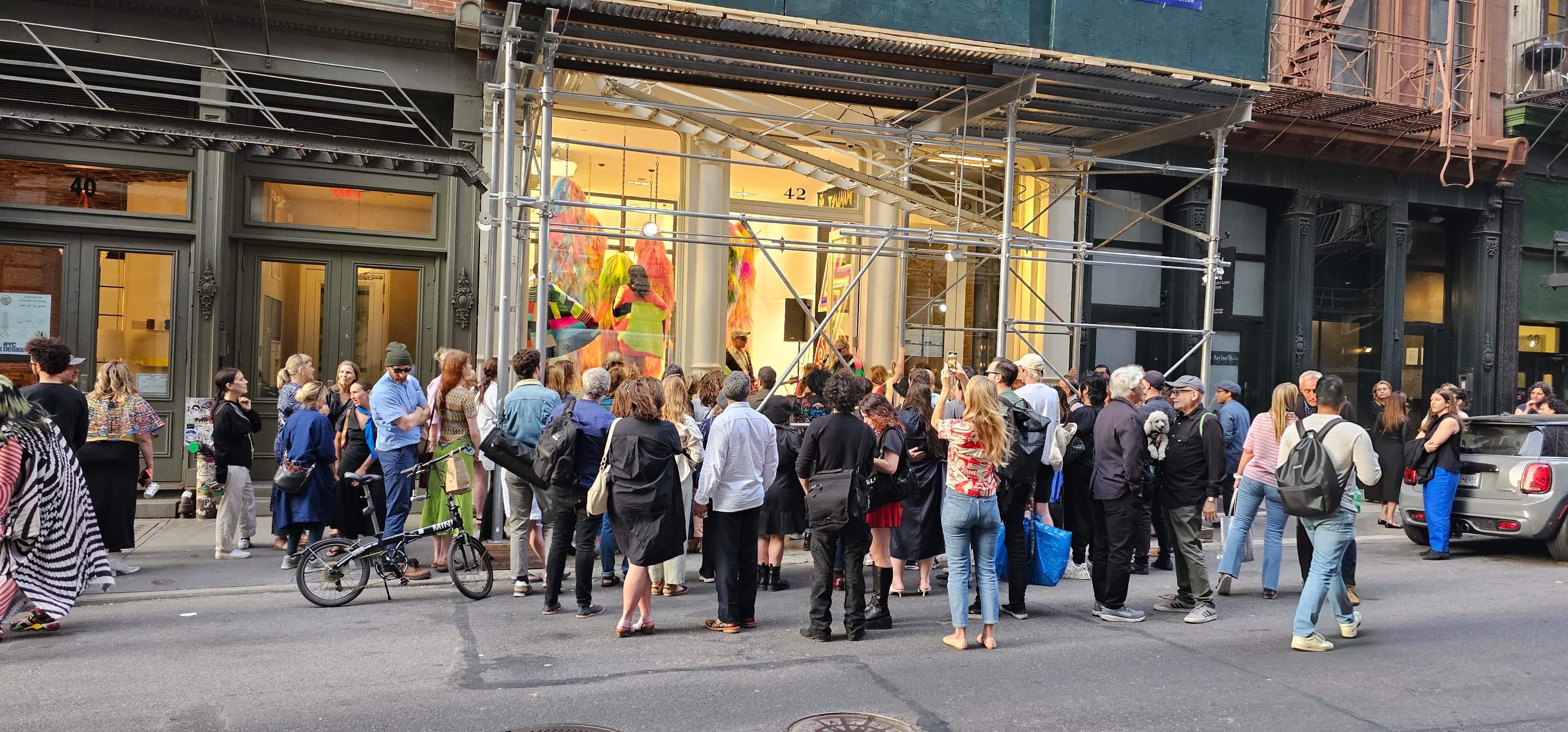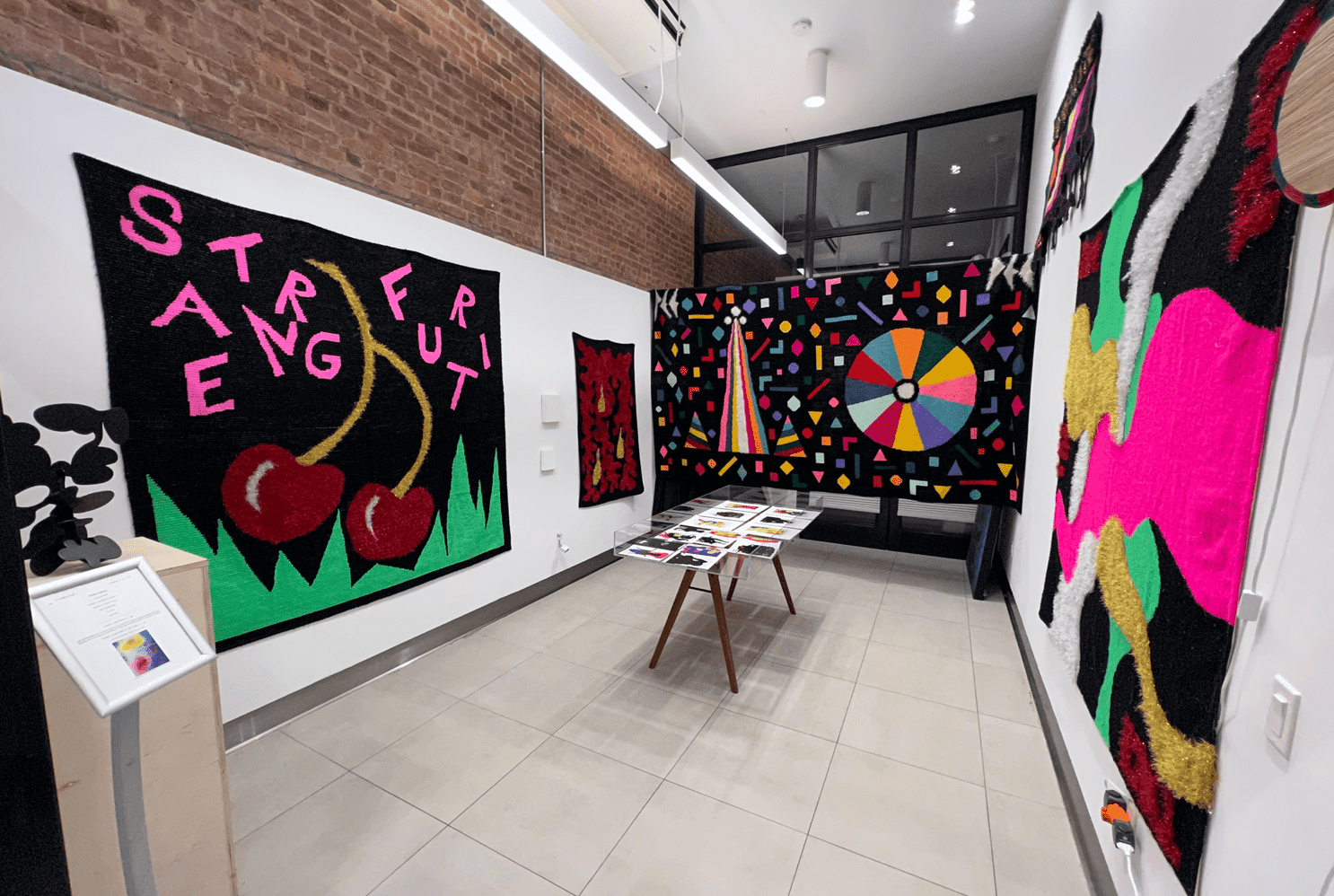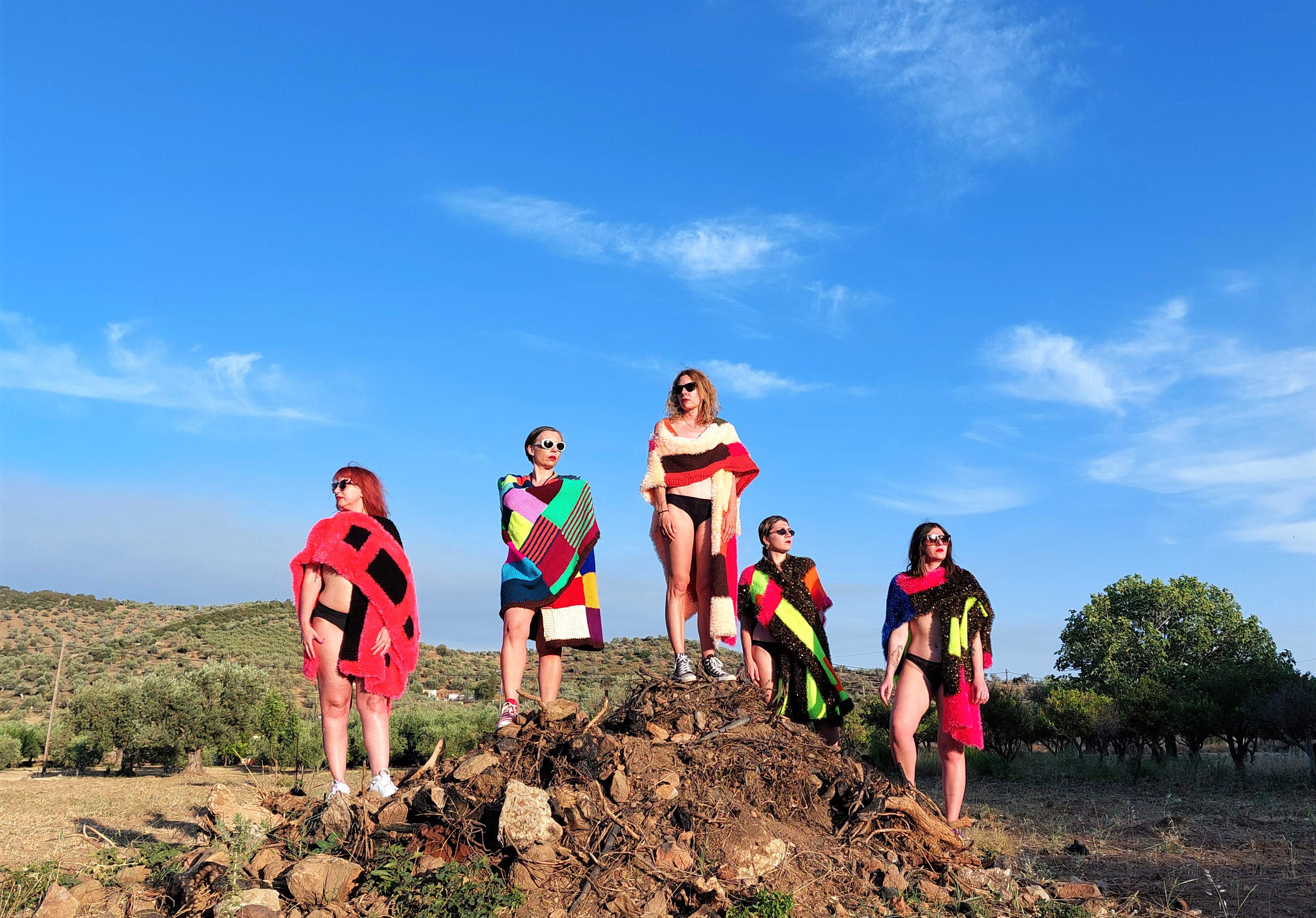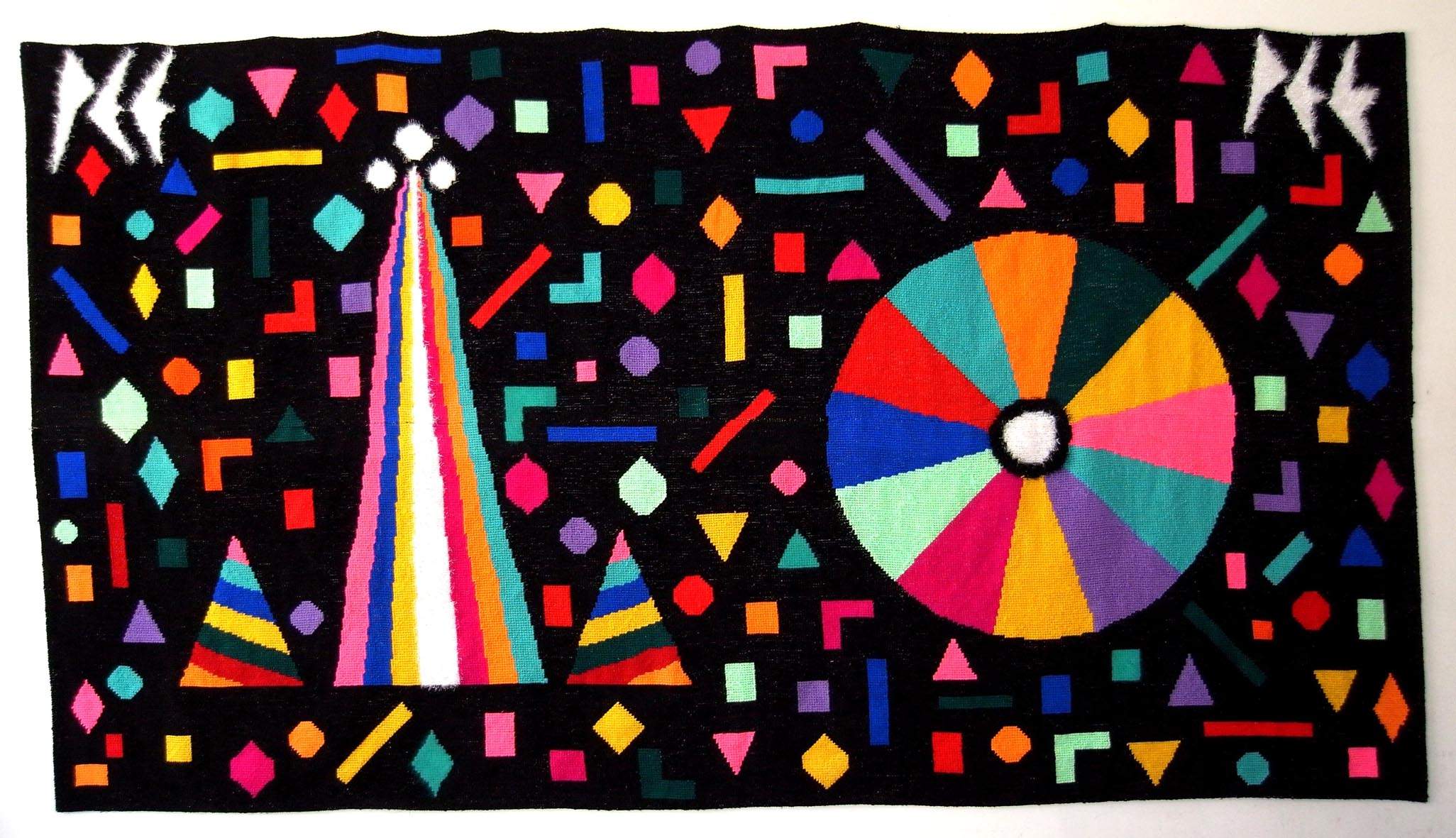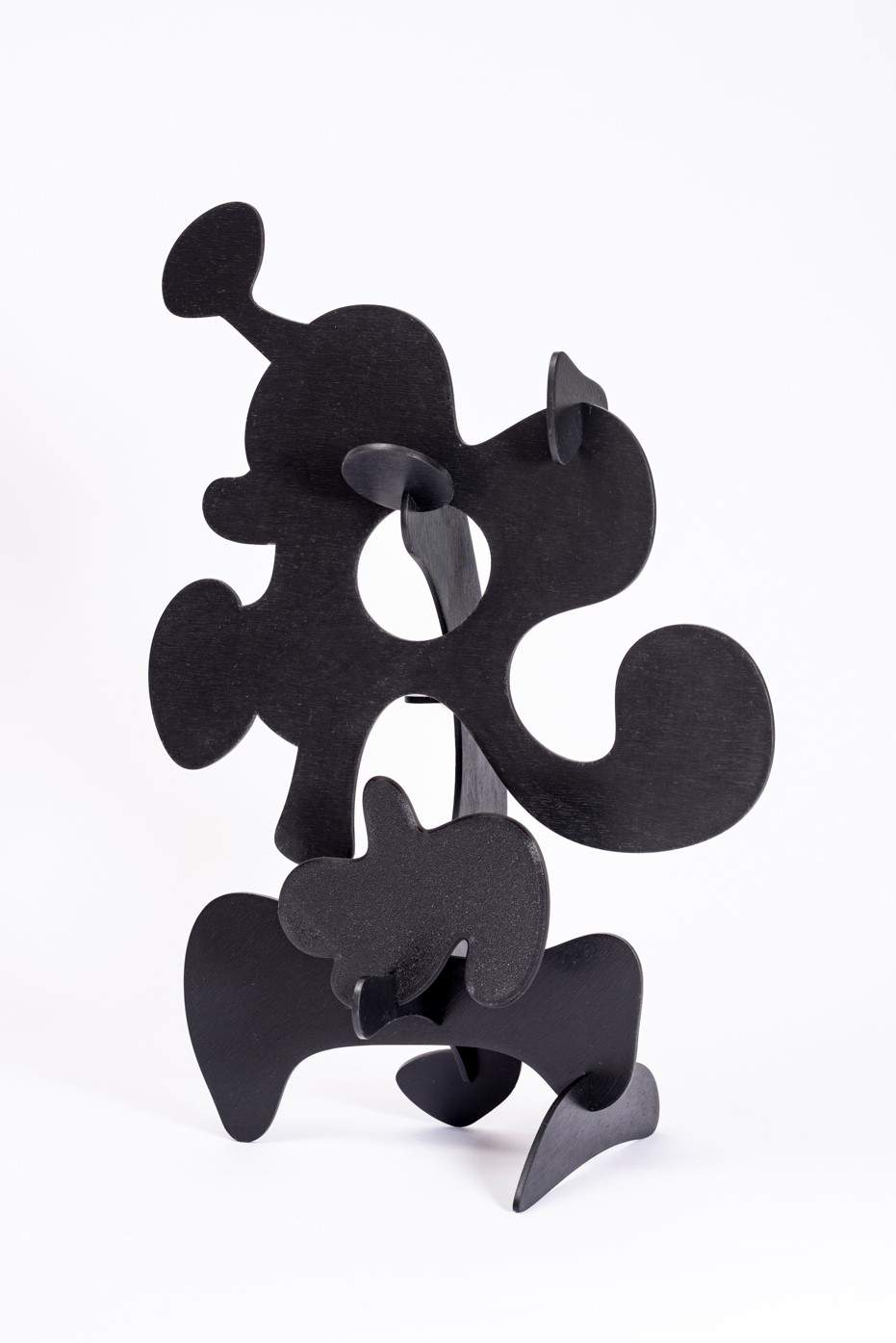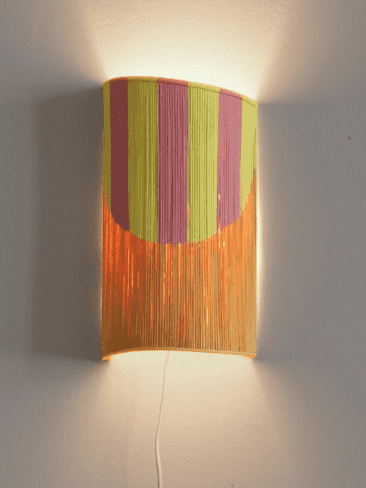Shoplifter/ Hrafnhildur Arnardóttir
The Callas / Lakis & Aris Ionas
Misha Milovanovich
Tula Plumi
Leah Singer
LIVE PERFORMANCE BY THE CALLAS AND THE CALLASETTES:
Dance by Daphne Kyriakidou with Irene Zografou and Dionisia Bosmi presenting their hand woven wearable tapestries
Exhibition run dates: May 16 - June 12, 2023 • 12 – 6pm
Curation & main text: Sozita Goudouna, PhD
The Opening Gallery is pleased to present the Group Exhibition Chromocommons featuring Fathom a selection of new works by Shoplifter/Hrafnhildur Arnardóttir and works by the artist collective The Callas, Misha Milovanovich, Leah Singer and Tula Plumi curated by Sozita Goudouna.
The exhibition coincides with the release of a unique publication by Leah Singer and a signed limited edition, as well as a series of numbered prints. The history of art is inseparable from the history of color and this history is a also. shared history. Chromocommons presents and puts on display sculptures, two-dimensional pieces, and live acts that explore the ways colors can be commons that enable us to create and live differently.
Visual perception is one of the most important mediums for our acquisition of knowledge and for our experience of our environment, of the physical world including our own bodies and others, while color is one of the most dominant components of our perception. Nevertheless, the physical world and the world of objects do not contain color and aren’t colored as we experience them. Color isn’t a physical property of objects; thus, our blood is not red, the sea isn’t blue, the trees aren’t green.
By definition, color suggests and implies connectivity and commonality since it exists only through connectivity.As Maurice Merleau- Ponty states ‘Claudel has a phrase saying that a certain blue of the sea is so blue that only blood would be more red. The color is yet a variant in another dimension of variation, that of its relations with the surroundings: this red is what it is only by connecting up from its place with other reds about it, with which it forms a constellation, or with other colors it dominates or that dominate it, that it attracts or that attract it, that it repels or that repel it. In short, it is a certain node in the woof of the simultaneous and the successive. It is a concretion of visibility, it is not an atom.’[1]
The color appearance of an object can be changed by changing the color of light that shines on it and the color of visible light depends on its wavelength. White light is composed of all of the colors of the rainbow, because it contains all wavelengths, and it is described as polychromatic light. Color glows with the light of the radiant sun and creates a relentless spectacle of sheer visibility, of an intense luminosity that can even be blinding. Drawing from our different perceptions of color, color vision deficiency and even “achromatopsia” (total color blindness), the participating artists trace common interpretations of the notion of color as sensation, visual and sensorial experience, psychological property of visual experiences, mental property, representation, construction of the brain, but most importantly the formulation of commons through color perception.
[1] [Originally from The Visible and the Invisible, pp. 130-55 in the 1968 translation. This version from Maurice Merleau-Ponty: Basic Writings, ed. Thomas Baldwin, Routledge (2004).]
The Shoplifter: Fathom
Synthetic and natural hair has become the signature art material of the Icelandic artist Hrafnhildur Arnardóttir, also known as Shoplifter. Each strand of hair is a drawing, the gestures of lines on a paper that have come to life existing as sculpture and colorful suspended three-dimensional paintings made with fibers. The fibers are tamed and transformed from their original intent into various artwork from braided and tufted wall work to her large-scale installations and small, microscopic curiosities mixed with other materials like handblown organically shaped glass capsules entrapping the fibers in her most recent series of work Phantoms. The Fathoms seem to sprout and grow of their own accord from the gallery ceiling, a floating forest. The hair is divided between the human-made and natural and within this installation that dichotomy seems to have completely dissolved. This world of Fathoms feels both universal and microscopic, you could be walking through nebulae or through synapses within your own mind. “Fathom” in English means to grasp or be able to dream or imagine something and is an old unit for measuring, from one palm of your hand the other. That same word, Faðmur in Icelandic, means to embrace or hug. The artist’s inspiration lies deep within her fascination with fibers, the texture, and colors that the artist selects, entangles and tames. The results a wild and brilliant chromatic ecstasy that makes you feel comforted, joyous, and embraced on a multi-sensory level. The colors penetrate the retina and trigger the neurons in the brain that automatically start producing oxytocin, the body's feel-good hormones, and together with its alluring and familiar texture we can be affected by the maximalism of her creativity.
Artist Bio:
Shoplifter / Hrafnhildur Arnardóttir is one of Iceland’s leading contemporary artists, based in New York. Working with both synthetic and natural hair, her sculptures, wall murals and site-specific installations explore themes of vanity, self-image, fashion, beauty and popular myth. For Shoplifter hair is the ultimate thread that grows from our body. Hair is an original, creative fiber, a way for people to distinguish themselves as individuals, and often an art form. Humor plays a large role in her life and work, sometimes subtly, but at other times taking over. Shoplifter represented Iceland at the Venice Biennale in 2019 and her installation Chromo Sapiens opened at the Icelandic Pavilion in May 2019 in Venice, Italy. The installation later traveled to Iceland opening at the Reykjavik Art Museum in January 2020. Other recent work includes solo exhibitions at Kulturhuset Stadsteatern in Stockholm, Sweden (2020), The Savannah Collage of Art and Design in Georgia (2020), Kiasma, the Finnish National Gallery (2019), the National Gallery of Iceland (2017), the Walt Disney Concert Hall in Los Angeles (2017) and the Queensland Art Gallery of Modern Art in Australia (2016). Notable projects and awards include her large window installation created in collaboration with art collective assume vivid astro focus (avaf) for MoMA, Museum of Modern Art in New York (2008), The Nordic Award in Textiles and The Prince Eugen Medal for artistic achievement from the King and Royal Crown of Sweden (2011).
The Callas / Lakis & Aris Ionas: Embroiderism Now!
At "Chromocommons," The Callas / Lakis & Aris Ionas, present a new and older body of hand embroidered tapestries. The pieces are designed by Lakis & Aris and crafted by their mother Ioanna and their aunt Anastasia, who are mostly based and work at The Callas farm (a DIY lab / studio / festival space / warehouse among olive and orange trees) in Thermissia, Peloponnese. Their influences ranging from Thomas Pynchon's helter skelter structures to Cycladic architecture, and from the No Wave scene to Rebetiko DIY recordings alluding to a freak-out blend of Mediteranean Psychladic collective creativity. During the opening night the open collective will present a new series of hand woven wearable tapestries and a live gig/performance by The Callas featuring The Callasettes. Embroiderism Now!
Artist Bio: The Callas / Lakis & Aris Ionas
The Callas is the tip of an open art collective that produces artworks, films and music initiated by the brothers Lakis & Aris Ionas. Selected art shows and collaborations include: Onassis Stegi (Athens, 2022), New Museum (NYC) - DESTE foundation (Athens) / Benaki Museum, Documenta 14, Palais de Tokyo (Paris), The Opening Gallery (New York), Family Business (NY), Athens Biennial (Athens), Andreas Melas Projects (Athens), State Of Concept (Athens), The Breeder (Athens), Kustera Projects (New York), Atopos CVC (Athens), Yinka Shonibare Space (London) among others. The collective has collaborated with Lee Ranaldo (Sonic Youth) and Jim Sclavunos (Nick Cave and The Bad Seeds) on music albums and live performances. In 2013 The Callas produced the film “LUSTLANDS” (HAOS film) that premiered at the 7th Athens Avant-Garde Film Festival. Their feature film "The Great Eastern” premiered at Onassis foundation – Stegi and Documenta 14."The Great Eastern," shot at DESTE’s foundation project space - Slaughterhouse in Hydra, premiered at Onassis foundation – Stegi and was screened at Documenta 14. Their recent film "SICK" was selected and premiered at Thessaloniki International Film Festival. Live performances include: Liverpool Psychedelic Festival (Liverpool), The Great Escape Festival (Brighton), Reeperbhan Festival (Hamburg), Indietracks Festival (Derby), Indigenes Festival (Nantes, France), Scala (London), The Lexington (London), Sala Apolo (Barcelona) and with the Thurston Moore band, The Brian Jonestown Massacre, Ty Segall, Television Personalities, Ian F. Svenonius and Grinderman. “Velvet Room” was established by The Callas in 2005 as one of the most active D.I.Y. cultural spaces/collectives in the center of Athens. The open collective curated some of the most seminal artzines in Athens (Velvet magazine, LUST magazine). They have also curated 5 bus tours/events throughout Greece with bands, artists, and filmmakers (Velvet Bus 2008 - 2011). According to OCULA Art and Stephanie Bailey "So many things have shaped the landscape of contemporary art in Greece since the 2000s, from the Athens Biennale's agitprop and Dakis Joannou's DESTE Foundation's summertime slaughterhouse shows on Hydra, to Gregory Markopoulos' unfolding magnum opus in Arcadia, Eniaios. Then there's The Callas." in https://ocula.com/magazine/features/the-callas-drop-lsd-in-athens/Misha Milovanovich: Noir
Misha Milovanovich’s new work for the Opening Gallery comprise of a one-of-a-kind sculpture. The sculpture is a fusion of fragmented cubism, biomorphic surrealism, and dynamic visual humor, and infused with shamanic force, which pays homage to the natural world. "The artist's latest work, crafted from Finnish Baltic Birch plywood and shellack, is a playful exploration of historical references that reimagines their antecedents, unleashing new prospects for the interpretation and significance of abstract forms in space." These Noir sculptures often embody organic contours and textures, evocative of natural shapes such as animals and plants. In addition to these influences, Misha's work draws inspiration from Japanese aesthetics and design principles, exemplified through simplicity, asymmetry, and the use of negative space and use of angle in joints. The new sculptures possess a unique quality of reflection, almost as if they were shadows cast by a hidden light source. This aspect of the sculptures adds an extra layer of depth and intrigue to their already captivating design, drawing the viewer's attention and encouraging a closer examination of the pieces. The interplay of light and shadow on the organic forms of the sculptures creates a dynamic visual experience that is sure to leave a lasting impression on anyone who sees them.
Artist Bio: Misha Milovanovich
Misha Milovanovic is a Belgrade-born artist based in London. She works across several mediums, from sculpture to painting and digital art. Characterized by vivid color, optical movement and energetic visual cadences, Misha's visual work fuses a diverse repertoire of images and forms. Misha's work is often a symphonic abstraction. Her colorful, densely layered works are held in a state of tension between order and chaos, rational structure and spontaneity. She combines depth and surface relief, orchestrating bold contrasts of form, texture, and space in her pictures. An intimate color palette of bodily fluids - red, pink, white, black, yellow, and brown - animate the writhing forms and the refracted memories of cartoonish cultural production. A cultural polymath, the artist is constantly engaged in observing society and it’s distortions of desire, lust and attitudes to the body. Traditional techniques have been studied and absorbed and although her work is partly conceptual, it's execution always reflects these hard-won technical abilities.
Leah Singer: The Ruby Drawings
In 1915 the Danish psychologist Edgar Rubin wrote a groundbreaking paper on form perception and introduced the study of figure/ground relationships. Rubin’s widely known black and white profile and vase illustration, used in the study, tricks the viewer into a back and forth of seeing either two profiles facing each other, or the shape of a vase formed in the center. Rubin discovered that in ambiguous drawings like this, the figure always dominates over ground and its what we see first. Willem De Kooning, although a pioneer of abstract expressionism, did not forsake the figure in his work and was criticized in his time for depicting women as harsh and unflattering. He said, “Beauty becomes petulant to me. I like the grotesque. It’s more joyous.” The Ruby Drawings are a mash up of silhouettes cut from rubylith — a masking film resistant to UV light used in the printing process to isolate parts of a photograph. The rubyliths were byproducts of newspaper production and were collected when I worked as a photographic archivist at the New York Daily News. The cut silhouettes have been scanned and used in groups to build enigmatic forms. The introduction of intersecting color further distorts the figure to ground connection. The amassed library of rubylith images has served in many of my projects including my copy newspapers—all graphic silhouettes with no text—produced at small printing presses across the country. As much as there is a formality to these works, a concern with form and color, figure and ground and a suggestion of the figurative inside the abstract, they were done quickly without too much deliberation to maintain a sense of play and spontaneity.
Artist Bio: Leah Singer
Leah Singer’s ever-evolving body of work includes film, sculpture, photography, printmaking, book publishing, product design, illustration, and jewelry. Her experiments with 16mm film provided her with a signature style that further evolved through her use of modified projectors during live musical performances. An interest in the silhouette grew from a self-published newspaper she made called copy. The paper was critically acclaimed; it is in the artist book collections of the Museum of Modern Art and the Whitney Museum of American Art. A limited collection of tote bags under the copy label sold at: Colette (Paris), A.P.C. (Paris, New York, Tokyo), Printed Matter (New York), and The New Museum Bookstore (New York). The newspapers popularity led to invitations from Nike to work on a New York City Runner’s Map followed by other projects such as the holiday visuals for a department store in Tokyo, the windows of Barneys New York’s flagship store, and t-shirt graphics for the Beijing Olympics. Her artwork has shown worldwide at such institutions as: Magasin3, Stockholm; Centre Pompidou, Paris; MACBA, Barcelona; The Museum of Contemporary Art, Los Angeles. She lives in New York City with her husband and frequent collaborator Lee Ranaldo (Sonic Youth) and their two sons.
Tula Plumi’s Light in January and Light in March
Tula Plumi’s Light in January and Light in March
Tula Plumi’s Light in January and Light in March are made of thin bamboo sticks glued together, creating surfaces that are painted with different colors and forms. A light is attached to each piece, creating a play on shadows and references to visual phenomena such as eclipses. The titles refer to W. Faulkner's novel Light in August.
Artist Bio: Tula Plumi was born in 1980 in Heraklion, Crete and currently lives and works in Berlin. She has studied at Athens School of Fine Arts. Recent shows include: Overturned at Art Geneve, Weavings at Museum Benaki 2019 Athens, Bed Manners at Kunstpunkt, Berlin 2019; Jelato for all, Jelato gallery, Mallorca 2019, A Museum – A History of 100 Years – Museum of Modern Greek Culture, Athens 2018. Her work has been shown at Musee national d’art modern Centre Pompidou, Emst National Museum of Contemporary Art, Athens, Daimler Contemporary, Berlin; Kunsthalle Athena, Athens Biennale 3.

